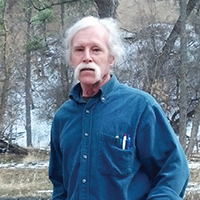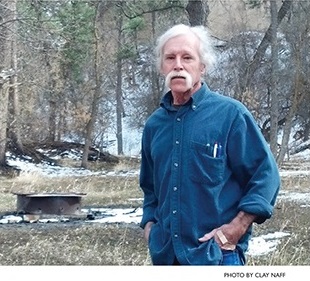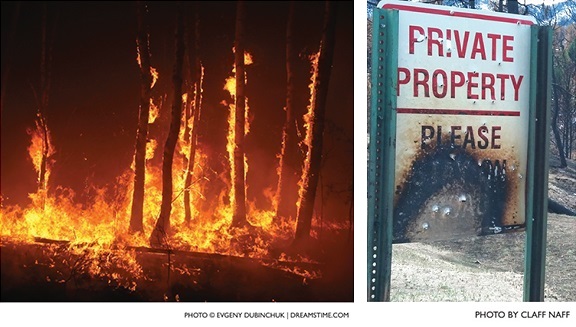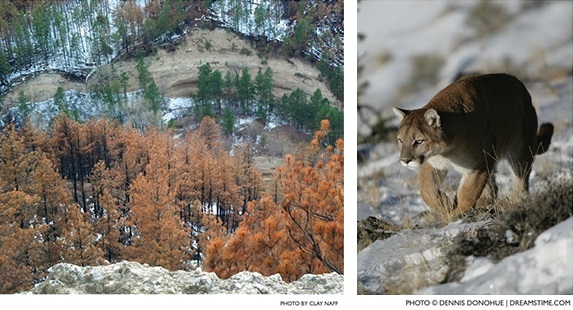The Lone Humanist One Man’s Struggle to Save Humanity By Defending the Prairie

America’s belief in climate change can be as fickle as the weather. Every time a heat wave or violent storm strikes, the polls register a rise in acceptance. Whenever it snows, every denier crows. The trouble is, anthropogenic climate change is such a slow moving, diffuse threat that all too many people find it hard to grasp. But what if it were happening in an old Western movie?
We’d find ourselves in a boomtown set against a beautiful landscape. There, we’d see the railroad baron, smugly checking his gold watch as his black-hatted, narrow-eyed goon ran a hand over his Colt 45 and readied for trouble. We’d see the corrupt mayor, the lazy sheriff, the beautiful and vulnerable widow and, circling the town with guns ablaze, the outlaws. We’d hear a tinkling piano in the watering hole where the local populace had gathered, trying to forget about the marauders tearing up their farms and ranches. And then, just as the outlaws burst through the saloon doors set to smash chairs, bust things up, and bring general ruination, a rugged individualist would come striding into town to set things aright.
If climate change were the villain of that movie, then Chadron, Nebraska, would be the town and Buffalo Bruce would be the rugged outsider.
The whole thing is a fantasy, of course. No one individual can stop the implacable forces of climate change. But journeying across the Great Plains to Northwest Nebraska, where farms give way to forests, buttes, and badlands, one sees just how that well-worn plot plays out in real life—the real life of an extraordinary ecologist, educator, and environmental activist named Charles Bruce McIntosh.
In a corner of the country where most folks proclaim themselves God-fearing climate-change deniers, McIntosh stands as a lone and fearless humanist. “I learned my religion from Mark Twain,” he says with a grin. As for why his fellow prairie homesteaders don’t acknowledge the encroaching threats, he’s blunt: “Religion is causing this! Or,” he growls, “I should say, superstition.”
The sixty-eight-year-old McIntosh puts his humanism into action by trying to save humanity from destroying the natural systems it depends on. “The Clean Water Act, the Clean Air Act, the Endangered Species Act—they’re all there to protect us,” he says.
And that’s why we’re heading through the lonesome Sand Hills region of Nebraska. Apart from the occasional herd of sheep or cows, the only living things to see off the road are cranes—thousands upon thousands of Sandhill cranes heading north on their annual spring migration. It’s a trek they’ve made for at least two million years, far longer than humanity has existed. Now, in the blink of a geological eye, global warming is shifting habitats, altering seasons, drying the waterways, and withering the forage under their wings. Yet, at our destination we’ll find an even more wondrous and wounding sight: in a hidden patch of wilderness, McIntosh tends a survivor of last summer’s savage wildfires, a survivor that happens to be one of the oldest, largest, and most ecologically significant living things in North America.
“I like to educate people on what we’re losing. In order to do that, I have to teach them what we have,” he says, quoting noted biologist Dr. David Suzuki: “Every living being is related, so get to know your brother! That’s what I try to do for people.”
Known to just about everyone in this state as “Buffalo Bruce,” the slim, spry, gaucho-mustached McIntosh fights the causes of climate change in the legislature, in the courts, in the classroom, and in the wild. As staff ecologist of the Western Nebraska Resources Council, he is a lead plaintiff in a lawsuit to stop the Keystone XL pipeline carrying tar-sands petroleum from Canada to the Gulf Coast. It’s just one of countless legal battles he’s waged.
On school visits, he sometimes shocks teachers with his straight talk about the dangers of overconsumption and overpopulation. “Growth should mean growing healthier rather than larger,” he says. “We know that the problem is way too many people consuming way too much stuff.” Regarding the swelling human population, McIntosh laments to students that, “People keep poppin’ ’em out.” He says teachers sometimes object to that message. His response: “We can’t lie to the kids.”
 As for being rugged, let’s just say Buffalo Bruce takes an outdoorsman’s role in the wild, battling with chainsaw, ax, and the occasional dead chicken to try to give native species a fighting chance. You might not think him tough at a glance, but this is a man who has suffered more than a hundred broken bones—both arms, both legs, his pelvis, and his neck—and sprung back from every one.
As for being rugged, let’s just say Buffalo Bruce takes an outdoorsman’s role in the wild, battling with chainsaw, ax, and the occasional dead chicken to try to give native species a fighting chance. You might not think him tough at a glance, but this is a man who has suffered more than a hundred broken bones—both arms, both legs, his pelvis, and his neck—and sprung back from every one.
In fact, his entire life story sounds a bit like a tall tale, and yet it all hangs together. The hundred-plus fractures were coded in his genes from the moment of conception. McIntosh was born with a condition called osteogenesis imperfecta, a rare genetic disease that leads to brittle, broken bones and makes it impossible to hold a regular job. But being declared disabled as a young man hasn’t stopped Buffalo Bruce from having a remarkable career. In fact, his determination has made him, literally, a poster boy for Nebraska’s Vocational Rehabilitation Council.
The second of four sons, McIntosh grew up in these parts with a father who was a scientist and a mother who trumped that as a Christian Scientist. Her belief in miraculous cures dominated his early years. “It’s hard for dads to out-argue moms in the home sometimes,” he wryly observes.
Things changed dramatically when she contracted incurable tuberculosis. While his mother wasted away in a hospital in the middle of the state, his father, by then a professor of geography at the University of Nebraska-Lincoln, quietly removed the boys from the Church of Christ, Scientist (founded by Mary Baker Eddy, a favorite target of Twain’s wit). Instead, he began taking them to the capital city’s Unitarian church.
It was a pivotal moment in the young teenager’s life. McIntosh grins as he recalls the liberating vista that greeted him. “Here was a church for ‘once upon a time I was a _____’ people. There were all kinds of former believers. No set creed.” Before long he came to regard his former religious education as nonsense. “It was all the same as Santa Claus and the tooth fairy.” Though not active in any organized humanist group, he now readily identifies himself as a humanist.
In 1964, two years after his mother died, McIntosh was scraping by in Lincoln with odd jobs and college classes—punctuated by broken bones and long recoveries—when the Smithsonian Institute came to town to recruit for an archeological dig. He landed a job that put him back out in the field and nearer to the nature he loved. More fractures followed, though, and eventually, having been declared disabled, he returned to lands his father owned in Northwest Nebraska and transitioned from C.B. McIntosh, job-seeker, to Buffalo Bruce, environmental activist.
Over the years, he’s chalked up many wins—legal protections for the prairie dog and the mountain lion, limits on uranium mining, a thinning out of invasive species, and, recently, recognition as Nebraska’s Conservationist of the Year—but now he faces an overwhelming foe: climate change has come to town.
I meet Buffalo Bruce in a coffee shop in Chadron, a Western town of 5,000 people, nestled in the foothills of the Badlands. His eyes twinkle, and he fairly bounces in his chair as he tells me of the latest development: a state senator friendly to his cause has introduced a bill to add a climatologist to the drought assessment team. But his sunny mood momentarily clouds over as he contemplates the scale of destruction that the team is bound to find.
“The balance of nature is long gone,” he says, explaining that we’ve passed the point where we can stop the rise of the oceans or rely on natural systems to clean up after us. Drought has taken hold and will only get worse. “If not for global dimming [from particulates in the atmosphere thrown up by coal plants, industry, and automobiles] we’d be totally fried.”
Chadron very nearly did fry late last summer. Two huge wildfires raced through the region, scorching national forest and private lands alike, including a forty-three-acre parcel of wilderness that Buffalo Bruce tends. Despite an all-out effort to contain the fires, including thousands of gallons of fire retardant dropped from the air, more than 100 square miles of forest and prairie burned, and the town found itself right in the line of fire.
No single instance of natural disaster can be attributed to climate change, but scientists have documented an alarming increase in the incidence and extent of wildfires. So, even though last summer’s dry spell was found to be an anomaly, it fell within a long-running trend of hotter temperatures, deeper droughts, and worsening wildfires. Buffalo Bruce is well aware of the trend. He was in Lincoln when the fires broke out in July but raced back to Northwest Nebraska to see the devastation for himself. Bone-dry pine trees burst into flame like matchsticks. Deer, bighorn sheep, mountain lions, and even many birds succumbed to the smoke and flames. As the fire approached, a motion-activated camera caught dramatic images of a mountain lion and her two cubs who fled as the fire closed in.
One of the cubs, parted from its mother, survived with burns on its paws. In hopes of keeping it alive through the winter, McIntosh took an unusual step. He brought raw chicken into the wilderness and left it for the cub. Sadly, its injuries likely proved fatal, and after a few weeks all traces of the young cat disappeared.
Despite that loss and many others, Buffalo Bruce has returned again and again to the wilderness he stewards in an attempt to document and salvage what he can. Now, in the first days of spring, we travel together over muddy roads and patches of snow through national forest land to what he calls an oasis on the Great Plains. It’s tucked away in a steep-sloped valley adjacent to the Bessey Ranger District of the Nebraska National Forest.
The first sign that the oasis has been stricken is literally a sign. The roaring fire scorched half the words off the aluminum “Private Property” notice posted at its entrance. A fine shroud of ash overlies the naked ground.

Blackened pines and ash trees litter the landscape. Remarkably, though, as we tramp through this graveyard of trees, a flash of white signals our elusive prize. And there it is: a stand of aspen.
Now, perhaps you’re disappointed. Even humanists may harbor unicorns in their minds. But aspen are no less impressive for lacking horns or hooves. What look like spindly white trees are actually the upward-reaching fingers of a vast clone—one that has been continuously living underground for tens of thousands of years. No one has analyzed the DNA of this particular one, says Buffalo Bruce, but he reckons it was here sipping from the valley stream when humans first wandered across the land bridge from Asia into the Americas more than 10,000 years ago. “I’m guessing twenty or thirty thousand years as the same living clone,” he says. It’s a staggering yet entirely plausible claim. Aspen studied in Utah have been found to be up to 80,000 years old (though not, perhaps, without some clonal division).
The above-ground appendages of the aspen are no less impressive. Here they stand amid scores of blackened trunks in all their white-clad glory. Enduring flames that topped out at 300 feet, the aspen survived with little more than a few scuffs to show for the ordeal.
Their secret? “They transpirate at a high rate,” says Buffalo Bruce. In other words, they draw water from the stream, up through their trunks, and out their leaves like the mister over a supermarket vegetable rack. That may be exaggerating a bit, but the USDA confirms that because they soak up so much water, aspen stands make great natural fire breaks.
But it’s not only in times of fire that the aspen serve. “They are important in any natural Western forest,” McIntosh says. This stand, for instance, “is like a condominium to birds. There can be four different species within thirty feet. I don’t know of any other plant community where that holds true.” And, indeed, even as we speak birds flutter in and perch on the branches around us. Certain butterflies also rely on the aspen as habitat, and many other fauna make use of it.
Yet, climate change has many arrows in its quiver. The wildfire may have passed, but the threat to the aspen has not. “We’re going to get a lot of new species coming in with climate change advancing twenty-four to twenty-six feet a day,” he says.

The largest of invaders is the Eastern red cedar, a tree once prized for its aromatic wood that now threatens wetlands, waterfowl, forest, and prairie. A thirsty, fast-spreading invader, it smothers grasslands and aspen stands alike, kills insects, birds, and even mammals. In this climate change Western, industry may be the villainous railroad baron, but to Buffalo Bruce, the cedar is the black-hatted goon. He has won accolades for leading chainsaw-toting posses on cedar-killing forays, and is the subject of a short film about defending aspen by taking out the outlaws.
Like the square-jawed stranger in the Western, Buffalo Bruce may come to town to put things right, but when the job is done, he’d be happy to tip his hat, turn on his heel, and head back out into nature. There are times when he gets so exasperated with the bone-headed, superstitious, faith-based passivity of people that he just wants to stay away.
“The Dismal River is my favorite place,” he says. “No towns along it, no roads parallel to it. You can backpack for days and see nature in all its diversity.” He yearns to build a dugout in the side of the hill overlooking his beloved aspen.
Unfortunately, the job in town is never done. As Buffalo Bruce sees it, human activity has set the earth on a path of climate change that will destroy not nature but civilization itself unless we act to mitigate it. “We all live downstream,” he observes. “When people say to me ‘there’s a plan,’ I tell them ‘we make the plan.’”
As for himself, at an age when most people are focused on retirement, McIntosh has plans aplenty. He’s a perennial speaker at Earth Day festivities in Omaha. This summer, he’ll lead a raiding party against invasive cedars on the Niobrara River. He’s part of an anti-fracking campaign. There’s another lawsuit to be waged, this one to get lead out of hunting ammunition and fishing weights. And finally—well, surely not finally—there’s his lobbying effort to have Congress pass legislation creating four new wilderness areas in Nebraska.
Having been named the Conservationist of the Year in 2011 has only redoubled his resolve. “It was humbling,” he says, “but it spurred me on. I mean, look around. It made me feel like I must not be doing enough.”![]()
